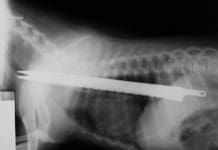12 Tips to Avoiding Trips to the Emergency Vet
Every year, thousands of dogs are treated in emergency veterinary hospitals across the country. I know; I spent nearly a decade as an emergency-room veterinarian. I always found it interesting that many of the most common injuries and illnesses I saw in emergency practice were also some of the easiest to prevent! Many of these problems can be avoided with a little common sense and preventative medicine.
Physical Exams for Senior Dogs
There are a number of ways that we can stay on top of health issues that creep up on our dogs with age. Annual veterinary visits are a staple in every healthy pet's life. A comprehensive physical exam from nose to tail is step one in picking up clues to underlying concerns at every age, but it becomes even more important in the senior years.
Dog Paw Cuts and Scrapes: How to Treat a Paw Injury
Your dog's paw pads act much like the soles of sneakers, protecting your dog's foot and cushioning each step. Paw pads are tough, but they can still be cut by sharp objects or worn off if your dog runs hard on rough terrain. What should you do when your dog cuts or tears a pad?
Get Your Dog to Rest After Surgery
Stay, and "Leave It." One can also work on increasing the duration of these behaviors at this time.üToss your dog's kibble onto a "snuffle mat" to increase the amount of time it takes him to sniff out and consume each nugget. These washable mats are easy to make or can be store-bought.üDr. Jessica Hekman uses trick training and scent-work exercises (seen here) to keep her usually busy English Shepherd
Hemangioma in Dogs
The cause of hemangiomas is idiopathic (unknown). These growths usually don't appear until at least middle age. Thin-skinned, light-colored breeds often experience hemangiomas. You'll most likely find a hemangioma on the dog's trunk or legs, especially hairless areas like the lower abdomen.
5 Steps to Safely Pull A Tick Off Your Dog
It's hard to say which is worse: running your hand over your dog and brushing against an attached tick, or seeing a tick skitter across your dog's face. Either way, the unwelcome arachnid must go. What should you do?
13 Household Items Toxic to Dogs
OK, we all know about #2. But many of these extremely common items are less hyped, and some are even ENJOYED by dogs!
Fecal Transplants for Dogs
A healthy microbiome destroys harmful pathogens, including disease-causing viruses, fungi, bacteria, and parasites. As a result, the microbiome is the immune system's first line of defense. Differences in microbiomes help explain why some dogs exposed to diseases like parvovirus, distemper, leptospirosis, Lyme disease, canine flu, heartworm, or kennel cough get sick while others remain symptom-free.
How Important is the Digestibility of Dog Food
What is digestibility and why does it matter? Digestibility reflects a food's ability to deliver essential nutrients to the dog who eats it. This ultimately affects not only defecation quantity and quality (how much your dog poops and how the poop looks and smells), and a dog's propensity for flatulence (no explanation needed), but more importantly, a dog's long-term health and wellness. The graphic on this page summarizes how digestibility is measured using feeding trials with dogs.
Laser Therapy Treatments for Arthritic Dogs
Arthritis pain, which affects four out of five older dogs, interferes with everything that makes life special for our best friends. Wouldn't it be great if we could turn the clock back? Technology may not yet offer a time machine, but it can seem that way for dogs treated with modern therapies that make them feel like puppies again. Would laser treatments, shock wave therapy, Pulsed Electromagnetic Frequency therapy, or other innovative treatments help your dog jump onto the sofa or run and play the way she used to?
Over-the-Counter Flea Medicine for Dogs
Last month, in Bravecto
Prescription Oral Flea Control Medication for Dogs
For several reasons, veterinarians tend to put the most stock in prescription oral or topical flea medications than any other preventatives. In fact, these are the two most effective solutions for killing fleas but they aren't without potential side effects and they should represent only a part of a dog owner's efforts to control fleas.



















